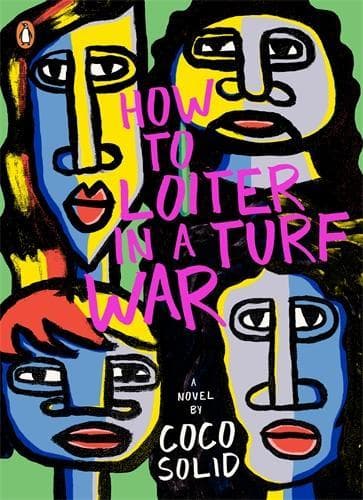Review: How to Loiter In a Turf War
Reviewed by Angelique Kasmara
Jessica Hansell, best known by her rap nickname Coco Solid, is one of Aotearoa New Zealand’s most impressive artists. As Coco Solid, Parallel Dance Ensemble, Badd Energy and Fanau Spa, she has a loyal international music following, heads record label and production house Kuini Qontrol, and is co-director of Onehunga community space Wheke Fortress. She’s also the creator of the beloved cartoon Aroha Bridge and her screenwriting credits range from Wellington Paranormal to Ahikāroa.
Hansell started writing How To Loiter In A Turf War during her time as the Fulbright Creative New Zealand Pacific writer in residence at the University of Hawai’i in 2018. The plot is simple: three friends navigate their way around Tāmaki Makaurau during a sweltering summer, dealing with issues of identity, family and bus services.
The fresh, energetic prose jostles alongside poetry, essay excerpts from (fictional) author and academic Piopi Ruta-Chris, line drawings and a photo gallery of Hansell’s larger works (in character as “Rosina”), which makes for a swift read. Although it’s referred to as a ‘novel’ on the front cover, it’s more novella in volume and a connector between the genre-dissolving anarchy of zine culture and more traditional literary work.
The inclusion of other art forms reflects the preoccupations of the magnificently drawn three main characters: the novella’s narrator Te Hoia, an acerbic political science student who is often found poring over the works of Ruta-Chris, Q the sensitive poet-in-denial, and fierce artist Rosina. Te Hoia’s inner voice has an engaging, upbeat rhythm:
“I bet Māori and Filipino Gods eavesdrop more than other Gods too.
Why did I get that combo?
They stand around the fountain of youth like it’s a watercooler.
Comparing notes with the Greek Gods about my psychotic thoughts.”
There’s a scene early on in an organic market, in an area formerly the domain of Chinese gardeners and wedding dressmakers, where Te Hoia and Q go loggerheads with an organic producer about the sausage in bread that they’re eating, revealing the kind of microaggressions they regularly have to deal with:
“— …You do the math - if you can.
Te Hoia’s face caves in.
— ‘If I can’?
Time slows down and ramps up simultaneously, like clashes of this kind tend to do.”
The theme of gentrification and property development being intrinsically tied to colonisation is expanded on in the following chapter when the trio view a group art exhibition, which also happens to be about gentrification. Rosina is the only brown artist included in the show, while the exhibition space itself is in the same block of shops where her uncle used to run a school uniform shop and programme which gave needy kids free uniforms and school supplies:
“Rosina’s grandfather was loved and neighbourhood-known before he died. In his final years though, he was treated like one of the faceless swamp people who delayed ‘the revitalisation’.”
A sharply observed scene follows with Rosina and fellow artist Paul. Her initial attraction for him rapidly wanes as “her intuition starts to rise from its nap” and is further dampened after her hilarious and on-point explanation about why she decided against roping in the hydrotherapist next door to perform “colonial colonics” as part of the show.
One chapter, Are You Ok? is deceptively slight. It uses a dream sequence in a surprising and perceptive way to illustrate missteps in language and how inadequate our responses to grief often are. Also speaking to the inadequacies of language are the musings in Kamran’s *Curry* *Burgers* *Kebabs* *Pizza* *Fried Chicken* about indigenous origin stories.
A note on formatting: em-dashes are used to mark speech, however, instead of tracking uniformly down the page, they often jump to the centre (mostly if a second person chimes in), but at other times they don’t, which makes for an often confusing reading experience, especially when trying to work out who is speaking. A few other inconsistencies occur that more careful editing could have ironed out, however these are minor irritations in this exciting, whip-smart read.
Reviewed by Angelique Kasmara
